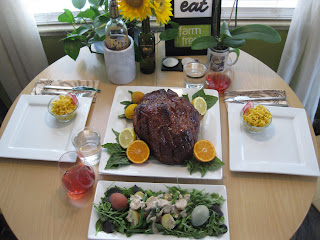Easter is one of my favorite holidays! I really do enjoy the celebration of spring, in our own unique yet traditional way. Geoffrey and I are in Denver without family so though we miss them all, we get the opportunity to create some pretty fun times and holiday experiences with the two of us. This year we decided to dye Easter Eggs and to do it with natural dyes. Here's how it went...
Making Dye: Boiling purple cabbage for blue dye
Making Dye: Cabbage on left, blue - beets on right, red
Coffee for light and dark brown
Turmeric for yellow and orange
Boiling eggs for cold dipping
Boiled eggs with dye
Finished eggs - cold dipped and boiled
So vibrant, so natural!
Monochromatic - blue, dyed with purple cabbage
Cabbage Dye: 1 egg boiled with cabbage & water 30 mins, 1 egg left in cabbage dye 30 mins, 1 egg left overnight in dye
Monochromatic - yellow
Turmeric Dye: 1 egg boiled with turmeric & water 30 mins, 1 egg left in turmeric dye 30 mins, 1 brown egg left in turmeric dye 30 mins
Beet Dye: 1 egg boiled with beet & water 30 mins, 1 brown egg left in beet dye 30 mins, 1 egg left overnight in dye
Monochromatic - earth
Lavendar "Earth" eggs 30 mins cabbage, 30 min beet dye. Brown egg = white egg left in coffee dye overnight.
These were dyed all natural free range chicken eggs, so I was able to incorporate them into our Easter Brunch!
Dijon-Marmalade Glazed Ham - Arugula, Dutch Potato, Green Bean salad with Home Made Creamy Walnut Dressing - Annie's Organic Bunny Rabbit Cheddar Pasta
And here's how we did it!
The tradition of dyeing eggs goes back to medieval times when people made pace eggs to celebrate spring and Pasch, the original name given to Easter or Passover.
Your kitchen is full of natural dyes. Common food items such as red cabbage, onion skins, and coffee can be used to transform plain white eggs into colorful Easter gems. Kids will especially love discovering all the different colors they can create -- let them experiment using hard-boiled eggs and bowls of cold dyes.
Tools and Materials
Natural dyeing agents (red cabbage, turmeric, onion skins, beets, and coffee)
3-quart pot (or larger)
White vinegar
Strainer
Small bowls
Eggs
Large metal spoon
Paper towels
Drying rack
Dye Recipes
Select a dyeing agent, and place it in the pot using the amount listed below. Add 1 quart water and 2 tablespoons white vinegar to pot; if more water is necessary to cover ingredients, proportionally increase the amount of vinegar. Bring to a boil, then lower heat. Allow the ingredients to simmer for 30 minutes. Strain dye into a bowl.
Red-cabbage dye: 4 cups chopped cabbage
Turmeric dye: 3 tablespoons turmeric
Onion-skin dye: 4 cups onion skins (skins of about 12 onions)
Beet dye: 4 cups chopped beets
Coffee dye: 1 quart strong black coffee (instead of water) Cold-Dipping Method
Cold-Dipping Method
With this method, the eggs and the ingredients for the dye are boiled separately. Using a metal spoon, lower cooled hard-boiled eggs into a bowl of cooled dye, and let them soak for as little as 5 seconds or as long as overnight, depending on the depth of color you desire. Remove eggs with spoon, pat dry with paper towels, and let dry on a wire rack. The cold-dipping method produces subtle, translucent shades, but can result in uneven coloring unless the eggs are rotated vigilantly while in the dye. For hollow eggs that will last indefinitely, cold-dip raw eggs, then blow them out after they are dyed.
Boiled Method
This method involves boiling the eggs with the dye; the heat allows the dye to saturate the shells, resulting in intense, more uniform color. Set raw eggs in a pot of strained dye; bring to a boil for the amount of time specified in our color glossary. Remove and dry eggs as with the cold-dipping method.
Finish (optional)
Natural dyes tend to fade over time, so finish any eggs you plan to keep with a matte or gloss acrylic spray varnish. To create an egg-spraying stand, stick a 6-inch length of wire into a block of Styrofoam; prop a hollow egg onto the wire through one of its holes. Spray egg with a coat of varnish in a well-ventilated area, and let dry.
Color Glossary
Natural dyes can sometimes produce unexpected results, so don't be surprised if, for example, your red-cabbage dye yields blue eggs. Use the following guide to help you achieve the colors you desire.
Deep Gold: Boil eggs in turmeric solution, 30 minutes.
Sienna: Boil eggs in onion-skin solution, 30 minutes.
Dark, Rich Brown: Boil eggs in black coffee, 30 minutes.
Pale Yellow: Soak eggs in room-temperature turmeric solution, 30 minutes.
Orange: Soak eggs in room-temperature onion-skin solution, 30 minutes.
Light Brown: Soak eggs in room-temperature black coffee, 30 minutes.
Light Pink: Soak eggs in room-temperature beet solution, 30 minutes.
Light Blue: Soak eggs in room-temperature cabbage solution, 30 minutes.
Royal Blue: Soak eggs in room-temperature cabbage solution overnight.
Lavender: Soak eggs in room-temperature beet solution, 30 minutes. Follow with room-temperature cabbage solution, 30 seconds.
Chartreuse: Soak eggs in room-temperature turmeric solution, 30 minutes. Follow with room-temperature cabbage solution, 5 seconds.
Salmon: Soak eggs in room-temperature turmeric solution, 30 minutes. Follow with room-temperature onion-skin solution, 30 minutes.
Read more at Marthastewart.com: Dyeing Eggs Naturally - Martha Stewart Crafts
 |
| Happy Easter! Stay tuned for Easter Brunch Recipes! |
|









































